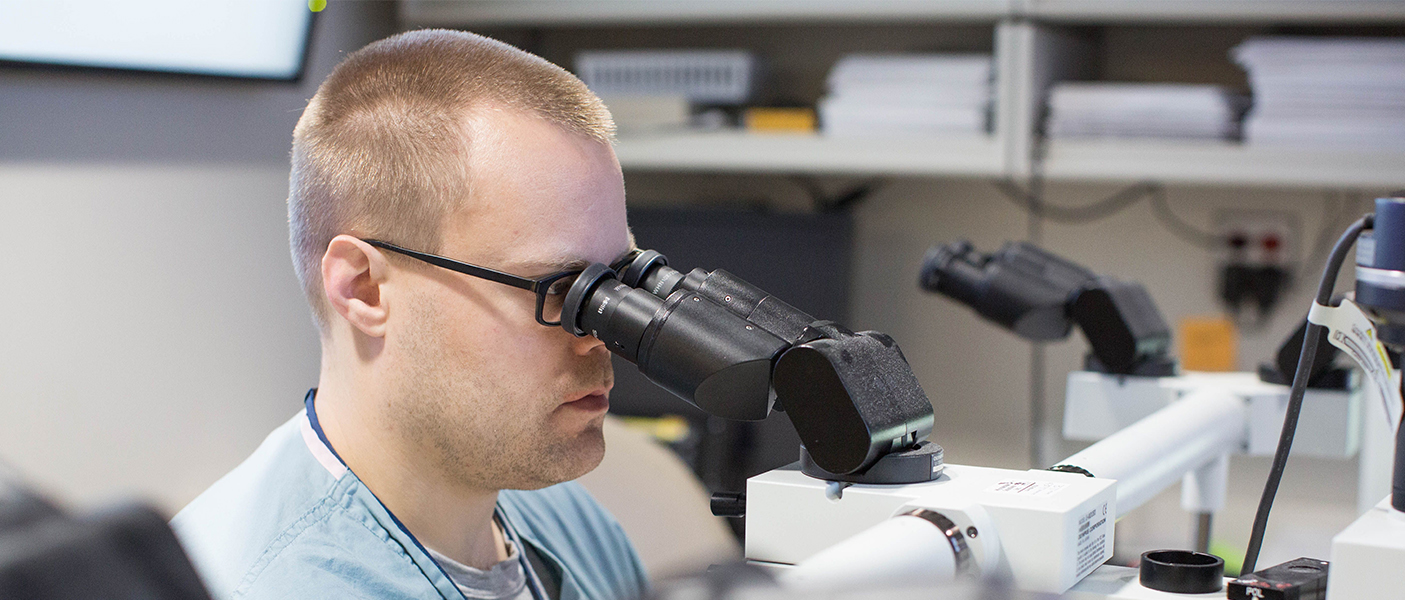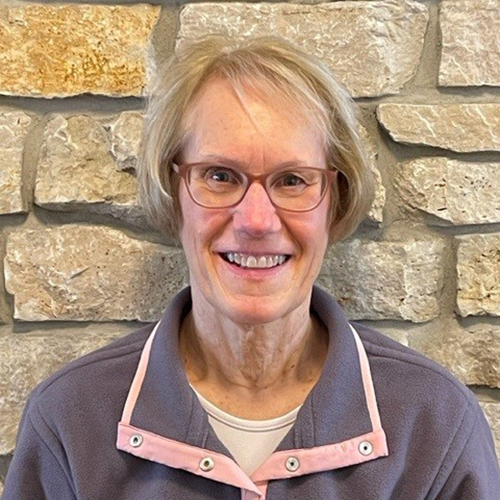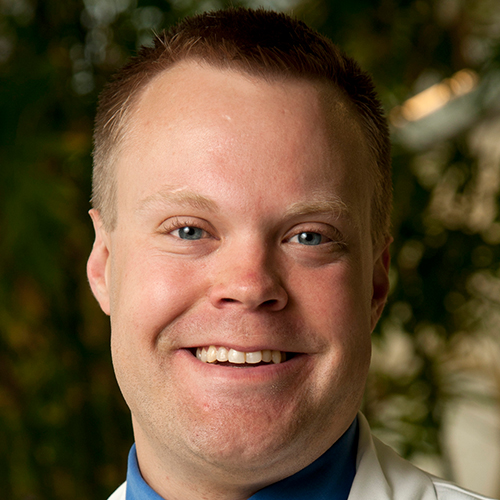

What greater gift could anyone give than to give someone the gift of life? Each year, approximately 6500 people in the United States make the choice to become a living organ donor so someone else can live. For each of these donations, pathologists ensure the donor and recipient are a match and that the donated organ is healthy. One of these donors, Cheryl Wonch, shared her story with us.
 Cheryl’s journey toward becoming a living organ donor began in 2017 when she received a letter from her church. A member of the congregation needed a kidney and couldn’t find a match. The letter asked parishioners if they could be tested to determine whether they might be a match. Cheryl didn’t know this individual but decided to do the “right thing” and be tested. She completed some paperwork, had her blood drawn, then waited.
Cheryl’s journey toward becoming a living organ donor began in 2017 when she received a letter from her church. A member of the congregation needed a kidney and couldn’t find a match. The letter asked parishioners if they could be tested to determine whether they might be a match. Cheryl didn’t know this individual but decided to do the “right thing” and be tested. She completed some paperwork, had her blood drawn, then waited.
Cheryl’s blood was sent to a pathology laboratory where it underwent a series of tests to determine if she might be a match for her fellow parishioner.
A few weeks later, Cheryl received a call from the transplant center. Cheryl was not a match. This disappointing news was quickly followed up with something unexpected. "You are a match for someone. Would you consider donating a kidney to someone else?" “I thought, I didn’t know the woman from the church who needed a kidney, so why would this be any different? Why would I give to her and not be willing to give to someone else?” Yet, she needed to talk to her husband and children about this decision. “My husband gave me the space to make this choice,” Cheryl reflected. “My children were more concerned about it but were supportive. My brother-in-law had been a bone marrow recipient, so we had personally experienced the benefits of organ donation, which made it a little easier. So, I decided to do the next right thing and continue the process.”
Once Cheryl contacted the transplant center to let them know that she was willing to proceed, there was more paperwork and more testing to be done, including bloodwork, urinalysis, and a 24-hour urine test to ensure her kidneys were functioning properly. After passing these tests and being deemed a good donor candidate, she underwent a CT scan and met with the surgeon and transplant team. It was then she received more unexpected news.
“Your CT scan revealed that you have a tumor on your kidney,” her surgeon explained. “You are no longer a candidate to be an organ donor and you will need to schedule surgery to remove the tumor.” Cheryl explained that the surgeon then discussed how the procedure would require a large abdominal incision and a lengthy recovery. Cheryl and her husband returned home to digest the news. They began to look for more information and learned about another person who had a similar tumor removed laparoscopically, with a much shorter recovery time. Days before her surgery was scheduled, Cheryl decided she needed a second opinion – and that is when she contacted the University of Michigan. “I called on a Monday and I was seen on Friday,” Cheryl stated, praising the care she received right from the start.
 “One of the reasons I like Michigan Medicine is that they think out of the box,” said Cheryl. “Dr. Samuel Kaffenberger, my Michigan Medicine urologist, thought the surgery could be done laparoscopically and stated that he would advocate for her kidney being donated.” But first, testing needed to be done. The first needle biopsy didn’t contain a good sample of the tumor, but the second hit the right spot and was reviewed by Dr. Aaron Udager, Associate Professor of Pathology specializing in genitourinary, head and neck, and surgical pathology. Udager determined the tumor was a clear cell papillary renal cell carcinoma, grade 3, which was a slow-growing tumor. CT scans showed the tumor was likely fully self-contained and located on the surface of the kidney. Following a discussion among pathologists, the surgical team led by Dr. Randall Sung, Professor of Transplant Surgery and Surgical Director for the Kidney and Pancreas Transplant Program, and others at a tumor board conference, the decision was made to proceed with removal of the kidney. Once removed, the tumor would be excised and, if the margins were clear and no signs of residual tumor present, it would be transplanted into the waiting recipient. Surgery was scheduled for August 2018.
“One of the reasons I like Michigan Medicine is that they think out of the box,” said Cheryl. “Dr. Samuel Kaffenberger, my Michigan Medicine urologist, thought the surgery could be done laparoscopically and stated that he would advocate for her kidney being donated.” But first, testing needed to be done. The first needle biopsy didn’t contain a good sample of the tumor, but the second hit the right spot and was reviewed by Dr. Aaron Udager, Associate Professor of Pathology specializing in genitourinary, head and neck, and surgical pathology. Udager determined the tumor was a clear cell papillary renal cell carcinoma, grade 3, which was a slow-growing tumor. CT scans showed the tumor was likely fully self-contained and located on the surface of the kidney. Following a discussion among pathologists, the surgical team led by Dr. Randall Sung, Professor of Transplant Surgery and Surgical Director for the Kidney and Pancreas Transplant Program, and others at a tumor board conference, the decision was made to proceed with removal of the kidney. Once removed, the tumor would be excised and, if the margins were clear and no signs of residual tumor present, it would be transplanted into the waiting recipient. Surgery was scheduled for August 2018.
“My husband and children were a bit anxious coming up to the surgery, but we had a vacation planned and I wanted to get this over with. My husband, as a cancer survivor, simply wanted the tumor out!” she reflected. The day finally arrived. The surgical team was ready. Pathologists were standing by to perform the frozen section to ensure the entire tumor was excised from the kidney. This time the news was good. The tumor was self-contained, and the margins were clear. There were no residual cancer cells left on the kidney! The kidney was approved for transplantation.
Following surgery, Cheryl recalls the first five days being a bit rough. But she followed her doctor’s directions and got up and walked like she was supposed to. “I did everything my doctor told me to do. We were leaving on vacation in seven weeks, and I wanted to be ready to go!” Due to her diligence, Cheryl was ready and left on vacation on schedule.
Since recovery, Cheryl indicates that she has felt great. She has experienced no negative effects of living with just one kidney. She is grateful that because she took the step to begin the donation process, her cancer was discovered early, and she is now cancer free five years later. Cheryl encourages others to consider becoming living organ donors. “I just did the next right thing every step along the way,” encourages Cheryl, “And in the end, I was blessed, and I hope that the recipient of my kidney has also been blessed.”
 ON THE COVER
ON THE COVER
Breast team reviewing a patient's slide. (From left to right) Ghassan Allo, Fellow; Laura Walters, Clinical Lecturer; Celina Kleer, Professor. See Article 2014Department Chair |

newsletter
INSIDE PATHOLOGYAbout Our NewsletterInside Pathology is an newsletter published by the Chairman's Office to bring news and updates from inside the department's research and to become familiar with those leading it. It is our hope that those who read it will enjoy hearing about those new and familiar, and perhaps help in furthering our research. CONTENTS
|
 ON THE COVER
ON THE COVER
Autopsy Technician draws blood while working in the Wayne County morgue. See Article 2016Department Chair |

newsletter
INSIDE PATHOLOGYAbout Our NewsletterInside Pathology is an newsletter published by the Chairman's Office to bring news and updates from inside the department's research and to become familiar with those leading it. It is our hope that those who read it will enjoy hearing about those new and familiar, and perhaps help in furthering our research. CONTENTS
|
 ON THE COVER
ON THE COVER
Dr. Sriram Venneti, MD, PhD and Postdoctoral Fellow, Chan Chung, PhD investigate pediatric brain cancer. See Article 2017Department Chair |

newsletter
INSIDE PATHOLOGYAbout Our NewsletterInside Pathology is an newsletter published by the Chairman's Office to bring news and updates from inside the department's research and to become familiar with those leading it. It is our hope that those who read it will enjoy hearing about those new and familiar, and perhaps help in furthering our research. CONTENTS
|
 ON THE COVER
ON THE COVER
Director of the Neuropathology Fellowship, Dr. Sandra Camelo-Piragua serves on the Patient and Family Advisory Council. 2018Department Chair |

newsletter
INSIDE PATHOLOGYAbout Our NewsletterInside Pathology is an newsletter published by the Chairman's Office to bring news and updates from inside the department's research and to become familiar with those leading it. It is our hope that those who read it will enjoy hearing about those new and familiar, and perhaps help in furthering our research. CONTENTS
|
 ON THE COVER
ON THE COVER
Residents Ashley Bradt (left) and William Perry work at a multi-headed scope in our new facility. 2019Department Chair |

newsletter
INSIDE PATHOLOGYAbout Our NewsletterInside Pathology is an newsletter published by the Chairman's Office to bring news and updates from inside the department's research and to become familiar with those leading it. It is our hope that those who read it will enjoy hearing about those new and familiar, and perhaps help in furthering our research. CONTENTS
|
 ON THE COVER
ON THE COVER
Dr. Kristine Konopka (right) instructing residents while using a multi-headed microscope. 2020Department Chair |

newsletter
INSIDE PATHOLOGYAbout Our NewsletterInside Pathology is an newsletter published by the Chairman's Office to bring news and updates from inside the department's research and to become familiar with those leading it. It is our hope that those who read it will enjoy hearing about those new and familiar, and perhaps help in furthering our research. CONTENTS
|
 ON THE COVER
ON THE COVER
Patient specimens poised for COVID-19 PCR testing. 2021Department Chair |

newsletter
INSIDE PATHOLOGYAbout Our NewsletterInside Pathology is an newsletter published by the Chairman's Office to bring news and updates from inside the department's research and to become familiar with those leading it. It is our hope that those who read it will enjoy hearing about those new and familiar, and perhaps help in furthering our research. CONTENTS
|
 ON THE COVER
ON THE COVER
Dr. Pantanowitz demonstrates using machine learning in analyzing slides. 2022Department Chair |

newsletter
INSIDE PATHOLOGYAbout Our NewsletterInside Pathology is an newsletter published by the Chairman's Office to bring news and updates from inside the department's research and to become familiar with those leading it. It is our hope that those who read it will enjoy hearing about those new and familiar, and perhaps help in furthering our research. CONTENTS
|
 ON THE COVER
ON THE COVER
(Left to Right) Drs. Angela Wu, Laura Lamps, and Maria Westerhoff. 2023Department Chair |

newsletter
INSIDE PATHOLOGYAbout Our NewsletterInside Pathology is an newsletter published by the Chairman's Office to bring news and updates from inside the department's research and to become familiar with those leading it. It is our hope that those who read it will enjoy hearing about those new and familiar, and perhaps help in furthering our research. CONTENTS
|
 ON THE COVER
ON THE COVER
Illustration representing the various machines and processing used within our labs. 2024Department Chair |

newsletter
INSIDE PATHOLOGYAbout Our NewsletterInside Pathology is an newsletter published by the Chairman's Office to bring news and updates from inside the department's research and to become familiar with those leading it. It is our hope that those who read it will enjoy hearing about those new and familiar, and perhaps help in furthering our research. CONTENTS
|

MLabs, established in 1985, functions as a portal to provide pathologists, hospitals. and other reference laboratories access to the faculty, staff and laboratories of the University of Michigan Health System’s Department of Pathology. MLabs is a recognized leader for advanced molecular diagnostic testing, helpful consultants and exceptional customer service.